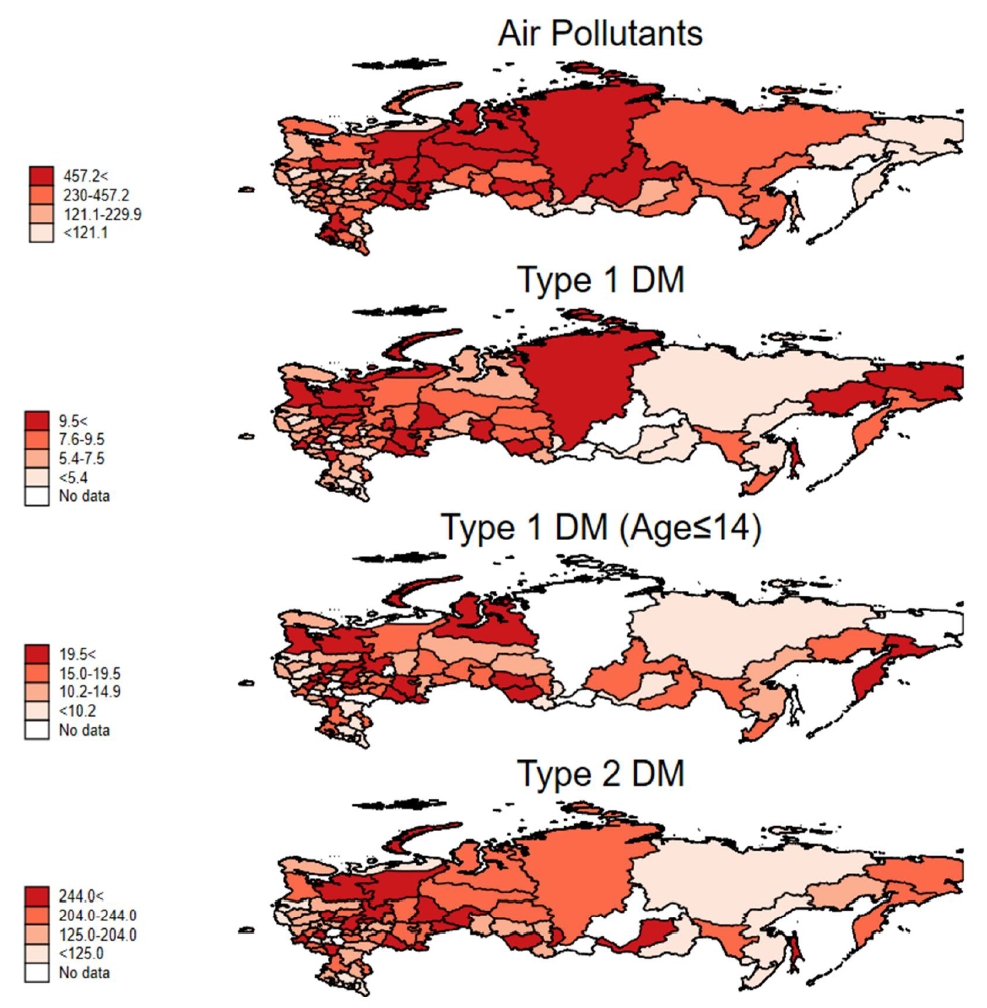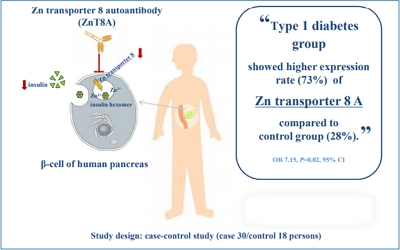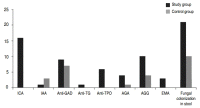Search
- Page Path
-
- HOME
- Search
- Original Article
- Endocrinology
- Correlation between total air pollutant emissions and incidence of type 1 diabetes in the Russian Federation
- Hoon Sung Choi, Jin Taek Kim, Ji-Young Seo, Faina Linkov, Evgeniy Shubnikov, Hong Kyu Lee
- Clin Exp Pediatr. 2021;64(10):525-530. Published online January 18, 2021
-

Question: Is there a quantitative relationship between air pollutant emissions and the incidence of type 1 diabetes (T1D)?
Finding: The incidence of T1D in each region of the Russian Federation correlated with the total air pollutants emitted each year.
Meaning: These findings suggest that air pollution contributes to the development of T1D.
- Zinc transporter 8 autoantibody in the diagnosis of type 1 diabetes in children
- Nur Rochmah, Muhammad Faizi, Siti Wahyu Windarti
- Clin Exp Pediatr. 2020;63(10):402-405. Published online October 6, 2020
-

Question: Can zinc transporter 8 autoantibody (ZnT8A) be used for diagnosing type 1 diabetes (T1D)?
Finding: Twenty-two of 30 subjects with type 1 diabetes (73.3 %) were positive for ZnT8A compared to 5 of 18 controls (27.8%).
Meaning: ZnT8A has potential for clinical applications in the diagnosis of T1D.
- Review Article
- Endocrinology
- Understanding of type 1 diabetes mellitus: what we know and where we go
- Chong Kun Cheon
- Clin Exp Pediatr. 2018;61(10):307-314. Published online October 4, 2018
-

The incidence of type 1 diabetes mellitus (T1DM) in children and adolescents is increasing worldwide. Combined effects of genetic and environmental factors cause T1DM, which make it difficult to predict whether an individual will inherit the disease. Due to the level of self-care necessary in T1DM maintenance, it is crucial for pediatric settings to support achieving optimal glucose control, especially...
- Original Article
- Endocrinology
- Autoimmunity and intestinal colonization by Candida albicans in patients with type 1 diabetes at the time of the diagnosis
- Semra Gürsoy, Tuba Koçkar, Sezen Ugan Atik, Zerrin Önal, Hasan Önal, Erdal Adal
- Clin Exp Pediatr. 2018;61(7):217-220. Published online July 15, 2018
-

Purpose: Type 1 diabetes mellitus (T1DM) is a chronic and immune-mediated disease, which is characterized by the progressive destruction of pancreatic beta cells. T1DM precipitates in genetically susceptible individuals through environmental factors. In this study, we aimed to evaluate the impact of autoimmunity and intestinal colonization of Candida albicans on the development of T1DM. Methods: Forty-two patients newly diagnosed with T1DM...
- Case Report
- Hepatic glycogenosis in type 1 diabetes mellitus mimicking Mauriac syndrome
- In Ah Jung, Won Kyoung Cho, Yeon Jin Jeon, Shin Hee Kim, Kyoung Soon Cho, So Hyun Park, Min Ho Jung, Byung-Kyu Suh
- Clin Exp Pediatr. 2015;58(6):234-237. Published online June 22, 2015
-
Hepatic glycogenosis in type 1 diabetes mellitus (DM) can be caused by poor glycemic control due to insulin deficiency, excessive insulin treatment for diabetic ketoacidosis, or excessive glucose administration to control hypoglycemia. Mauriac syndrome, which is characterized by hepatomegaly due to hepatic glycogenosis, growth retardation, delayed puberty, and Cushingoid features, is a rare diabetic complication. We report a case of...
- Review Article
- Nonpharmacological management and psychosocial support for children and adolescents with type 1 diabetes
- Jae Ho Yoo
- Clin Exp Pediatr. 2011;54(2):45-50. Published online February 28, 2011
-
Compared to that in the Caucasian population, type 1 diabetes mellitus (T1DM) incidence rates are very low in Koreans. Therefore, compared to the recent development of pharmacological therapy applicable to Korean children with T1DM, interest in nonpharmacological therapy and psychosocial support systems remains low, as is the development of Korean-style T1DM education programs for therapeutic application. Children who have been...
- Original Article
- Comparison of clinical and laboratory characteristics in children with type 1 diabetes according to pancreatic autoantibodies
- Ji Hae Choi, Min Sun Kim, Chan Jong Kim, Jong Duk Kim, Dae-Yeol Lee
- Clin Exp Pediatr. 2010;53(3):414-419. Published online March 15, 2010
-
Purpose:The purpose of this study was to determine whether there is any difference in the clinical and laboratory characteristics of patients with autoantibody-positive and patients with autoantibody-negative type 1 diabetes at initial presentation. Methods:We analyzed 96 patients under 18 years of age with newly diagnosed type 1 diabetes. One or both of the pancreatic autoantibodies-glutamic acid decarboxylase autoantibodies (GADA) and... -
- A study of the development of macrovascular complications and factors related to these complications in young adults with childhood/adolescence-onset type 1 diabetes mellitus
- Min Jae Kang, Joo Hwa Kim, Hye Rim Chung, Young Ah Lee, Choong Ho Shin, Sei Won Yang, You Yeh Kim, Seon Mi Jin, Chung Il Noh
- Clin Exp Pediatr. 2009;52(2):220-226. Published online February 15, 2009
-
Purpose : Macrovascular complications are the main cause of mortality in type 1 diabetes mellitus (T1DM). The purpose of this study was to clarify the presence of early vascular changes and to assess the risk factors of macrovascular complications in young adults with T1DM diagnosed in childhood and adolescence. Methods : Seventy-two patients (23.9¡¾2.4 years) with T1DM diagnosed before 18 years... -
- Early assessment of atherosclerosis in children with type 1 diabetes
- So-Yoon Park, Seok Jeong Kang, Kwang Hae Choi, Yong Hoon Park, Young Hwan Lee
- Clin Exp Pediatr. 2008;51(7):747-753. Published online July 15, 2008
-
Purpose : Diabetes mellitus is a major risk factor for the development of cardiovascular disease. Early atherosclerotic changes in the arterial walls begin in adolescence and the risk factors are associated with its development. To assess the usefulness of carotid artery intima-media thickness (IMT), as a marker of early atherosclerosis, we evaluated the structural and functional characteristics of the carotid... -
- The effect of Lantus on glycemic control in children and adolescents with type 1 diabetes mellitus
- Young Jun Rhie, Hyun Wook Chae, Ho Seong Kim, Duk Hee Kim
- Clin Exp Pediatr. 2007;50(6):565-569. Published online June 15, 2007
-
Purpose : With a duration of action of approximately 24 hours and peakless levels, Lantus is a more physiologic basal insulin analogue compared with NPH. The aim of this study was to compare the glycemic control of Lantus plus Humalog with that of premixed insulin in children and adolescents with type 1 diabetes mellitus. Methods : The subjects consisted of... -
- A study and the growth and the development of microvascular complications in patients with type 1 diabetes mellitus
- Young Ah Lee, Kyong-Ah Yun, Choong Ho Shin, Sei Won Yang
- Clin Exp Pediatr. 2007;50(2):190-197. Published online February 15, 2007
-
Purpose : Reduced growth and microvascular complications have been recognized as consequences of type 1 diabetes mellitus (T1DM). We assessed the effect of T1DM on growth and factors associated with the development of microvascular complications. Methods : We conducted a retrospective longitudinal evaluation of 154 patients above 16 years of age. We analyzed factors which affect final height standard deviation scores... -
- Tumor Necrosis Factor and Lymphotoxin-α Gene Polymorphism in Korean Children with Type 1 Diabetes
- Jin Soon Suh, So Young Park, Min Ho Jung, Byung Kyu Suh, Tae Gyu Kim, Byung Churl Lee
- Clin Exp Pediatr. 2005;48(8):871-876. Published online August 15, 2005
-
Purpose : Recently, it was reported that tumor necrosis factor(TNF) and lymphotoxin-α(LT-α) gene regions might be a susceptible loci to type 1 diabetes in Japanese. The purpose of this study was to investigate the association of TNF and LT-α gene polymorphisms with disease susceptibility in Korean children with type 1 diabetes. Methods : Forty-nine Korean children with type 1 diabetes(29... -
- Human Leukocyte Antigen(HLA) Genotypes and Thyroid Autoimmunity in Korean Patients with Type 1 Diabetes
- So Young Kang, Chung Ho Shin, Sei Won Yang, Myoung Hee Park, Jeesuk Yu
- Clin Exp Pediatr. 2005;48(6):624-633. Published online June 15, 2005
-
Purpose : This study analyzed the expression of HLA-DR and DQ genotypes and anti-thyroid autoantibodies[anti-thyroid peroxidase(TPO) and anti-thyroglobulin(TG) antibodies] in Korean patients with type 1 diabetes(T1DM) to investigate the susceptible HLA alleles to T1DM in Korea and the prevalence of thyroid autoantibodies and their significance for the development of thyroid disorders. Methods : A total of 59 Korean patients with type... -
- Clinical Characteristics of Autoimmune Thyroid Disease Developed in Patients with Type 1 Diabetes Mellitus
- Se Min Lee, Hye Rim Chung, Su Young Hong, Choong Ho Shin, Sei Won Yang
- Clin Exp Pediatr. 2005;48(3):292-297. Published online March 15, 2005
-
Purpose : It is known that 3-50 percent of type 1 diabetes mellitus(T1DM) patients develop autoimmune thyroid disease. We analyzed the clinical characteristics of autoimmune thyroid disease(AITD) developed in patients with T1DM in Korean. Methods : The medical records of 139 patients, who were followed up in Department of Pediatrics, Seoul National University Children's Hospital from Jan. 1981 to Jul. 2004,... -
- Factors Related to the Development of Microalbuminuria in Children and Adolescents with Type 1 Diabetes Mellitus
- Min Ho Jung, Pei Tai Wan, Choong Ho Shin, Sei Won Yang
- Clin Exp Pediatr. 2001;44(5):577-586. Published online May 15, 2001
-
Purpose : We observed the prevalence rate of microalbuminuria(MA) and its relationship with the various clinical factors in children and adolescents with type 1 diabetes mellitus(DM). Methods : Seventy two children and adolescents(26 males and 46 females, 17.1±3.0 years) were included. MA was defined as 24 hour urine microalbumin >30mg/day(20μg/min). Subjects were classified into three groups(normoalbuminuria, transient MA, or persistent MA).... -
- Factors Influencing the Onset of Honeymoon Period in Children with Type I Diabetes Mellitus
- Jin Soon Hwang, Sei Won Yang
- Clin Exp Pediatr. 2000;43(8):1106-1110. Published online August 15, 2000
-
Purpose : Type I diabetes mellitus(DM) is an autoimmune disease which decreases insulin secretion of pancreatic β-cell. The honeymoon period in type I DM is known to be related to the partial recovery of C-peptide and preservation of pancreatic β-cell function. The aim of this study was to determine factors influencing the onset of honeymoon period in children with type... -
-

-
-

-

-
Impact Factor4.2
-
6.52022CiteScore92nd percentilePowered by







